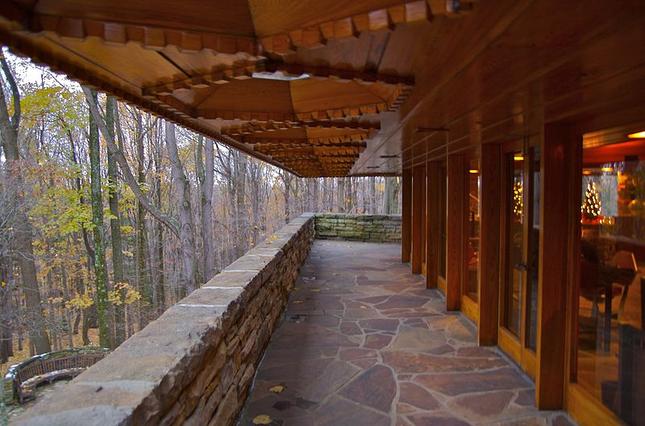Born on June 8, 1867, Frank Lloyd Wright had been practicing architecture for more than 40 years when, in December of 1934, he visited Bear Run, the waterfall on the Laurel Highlands property where department store magnate Edgar J. Kaufmann planned to build a summer home.
Wright was greatly admired for his Prairie houses, Unity Temple and Larkin Building of the early 1900s; and for his Imperial Hotel and California textile-block houses of the 1920s. In between, he had survived scandal and tragedy. Now, during the Great Depression and the rise of the International Style, he was out of style and mostly out of work.
Kaufmann was in Milwaukee in September of 1935 and called Wright to say he’d like to drive out to the architect’s Wisconsin studio, Taliesin, to see the plans. Though, it is generally agreed, he had worked them out in his head over the preceding months, Wright drew up the plans for what was to become Fallingwater between the phone call and Kaufmann’s arrival.
Wright’s masterstroke was to site the house above the falls, as if encased in the ledge. Kaufmann had naturally expected the house — made of Pottsville sandstone, with beige concrete cantilevers and glass framed in Cherokee-red steel — to have a view of the falls. Instead, house and landscape are one; a boulder juts into the open living area next to the hearth and a trap door leads to the falls, the sound of which is constantly heard.
Fallingwater was completed in 1937, with a guesthouse added a few years later. A mausoleum with bronze doors by Alberto Giacometti was constructed in 1957. In 1963, Edgar Kaufmann, Jr., who worked at the Museum of Modern Art and taught at Columbia University, donated Fallingwater and the 1,500-acre surrounding property in Mill Run to the Western Pennsylvania Conservancy, which operates a variety of guided tours, daily except Wednesday, March through November.
Also available for advance purchase online at fallingwater.org are tours, with or without lunch or dinner, of Wright’s Duncan House, built in 1957 and relocated 50 years later from Illinois to Polymath Park in Acme, Pennsylvania, a few miles north of Mill Run. Keeping Duncan House company in Polymath Park are three homes — Balter House, Blum House and Dream House — designed by Wright apprentices. All are in Wright’s Usonian style (the name is a synonym for American, with the additional sense of usability). For information about staying in one of the Polymath Park houses, visit franklloydwrightovernight.net.
The third Wright house open to the public in the Laurel Highlands is the Usonian house Kentuck Knob, named for the 2,050-foot hill on which it sits, overlooking the Youghiogheny River Gorge. Located in Chalk Hill, a few miles south of Mill Run, it was built in 1954 for Isaac Newton Hagan, grandson of the founder of an ice-cream business. Since I.N. and Bernardine Hagan moved in in 1956, Kentuck Knob is marking its 60th anniversary this year. Among the highlights of a visit are furniture by Wright and a sculpture garden. For tickets, visit kentuckknob.com.


